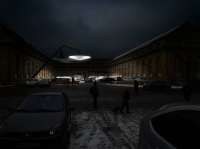Marché Couvert, Metz, France 2010 City of Metz, France Structural Engineer : Bollinger + Grohmann (France)
The advent of artificial light, which grew strongly during XXst century, has gradually freed the man from the natural rhythms of the day and night and allowed him to redefine the world around him. Evolution lighting technologies - from the oil lamp to the fluorescent tube, passing through the incandescent light bulb - has gradually lengthened our standby time, so that we can say without exaggeration that our society "never sleeps". If the modern project was to extend the day and its activities during the night, overnight, without interruption, we want with this project, promptly reverse this phenomenon. We do not postulate for the return of the pre-modern night, but rather the night of the beginning of modernity. If the "perversion" of the natural night by artificial light is inevitable, we want to preserve the qualities of its disparate atmospheres, those that contemporary homogeneous over-lighting impoverishes. This is altering the modern night by reintroducing quality that lighting systematic cities wiped out : heterogeneity. A "lamp" consisting of sixty four fluorescent sources, replaces the multitude of sources that currently illuminates uniformly the square. This public space is redefined according to the illuminance of 1500 lux under the "lamp" to 5 lux at the end of the square. Initially envisaged in 1762, as the Episcopal Palace, the building designed by architect Jacques Francois Blondel became a market in 1831. Designed to enhance the great classical portal of the cathedral of Metz, the market, classical building, seems not be expected for a particular function. Almost abstract architecture, religious palace - civil market, multiple successive uses have been affected. The light source, placed asymmetrically in the length, width and height of the square, enlighten unevenly in every way. Associated with the specific production of "parasols", this source will increase the disparity of public space defined by dark areas and bright areas. The "parasols" which will alternately house a variety of diurnal uses and nocturnal uses. Our project seeks to introduce new unexpected uses in public space.
Marché Couvert, Metz, France 2010 City of Metz, France Structural Engineer : Bollinger + Grohmann (France)
The advent of artificial light, which grew strongly during XXst century, has gradually freed the man from the natural rhythms of the day and night and allowed him to redefine the world around him. Evolution lighting technologies - from the oil lamp to the fluorescent tube, passing through the incandescent light bulb - has gradually lengthened our standby time, so that we can say without exaggeration that our society "never sleeps". If the modern project was to extend the day and its activities during the night, overnight, without interruption, we want with this project, promptly reverse this phenomenon. We do not postulate for the return of the pre-modern night, but rather the night of the beginning of modernity. If the "perversion" of the natural night by artificial light is inevitable, we want to preserve the qualities of its disparate atmospheres, those that contemporary homogeneous over-lighting impoverishes. This is altering the modern night by reintroducing quality that lighting systematic cities wiped out : heterogeneity. A "lamp" consisting of sixty four fluorescent sources, replaces the multitude of sources that currently illuminates uniformly the square. This public space is redefined according to the illuminance of 1500 lux under the "lamp" to 5 lux at the end of the square. Initially envisaged in 1762, as the Episcopal Palace, the building designed by architect Jacques Francois Blondel became a market in 1831. Designed to enhance the great classical portal of the cathedral of Metz, the market, classical building, seems not be expected for a particular function. Almost abstract architecture, religious palace - civil market, multiple successive uses have been affected. The light source, placed asymmetrically in the length, width and height of the square, enlighten unevenly in every way. Associated with the specific production of "parasols", this source will increase the disparity of public space defined by dark areas and bright areas. The "parasols" which will alternately house a variety of diurnal uses and nocturnal uses. Our project seeks to introduce new unexpected uses in public space.

